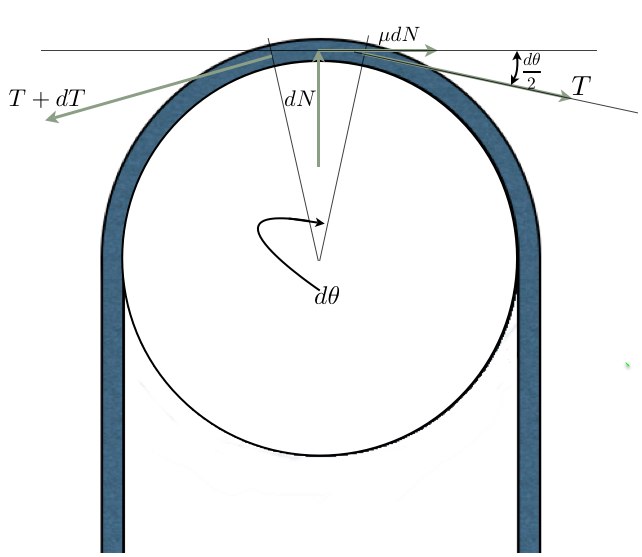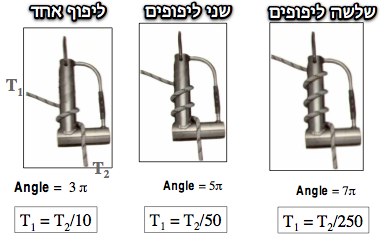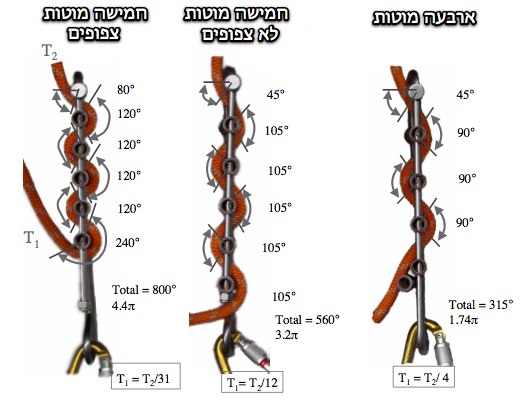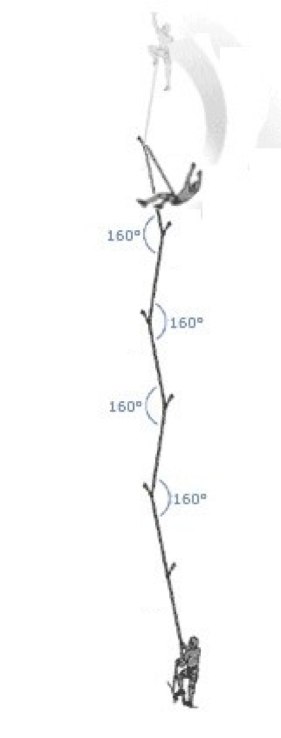הבדלים בין גרסאות בדף "?How do friction devices work"
| שורה 145: | שורה 145: | ||
===Example 3: [[Figure of eight]]=== | ===Example 3: [[Figure of eight]]=== | ||
[[image: Eight_friction.jpg|right|350px]] | [[image: Eight_friction.jpg|right|350px]] | ||
| + | If we look closely at the way the rope passes through a Figure of eight, we can see the difference between the two extreme cases. The first case is the one where it is the easiest to give out rope, and friction is minimal. The total contact angle is then 540° (180°+180°+180°), or <math>3\pi</math>. | ||
| − | + | In the other extreme case, where there is maximum friction, and the device is "locked", the breaking rope does a 270° (instead of 180° in the previous case) and the total contact angle 630° or <math>3.5\pi</math>. | |
| − | + | So, if we use the capstan friction calculation we find that with a Figure of eight, the difference between minimum and maximum friction is only 16.66%. It is a widely accepted that a Figure of eight is not the best device to belay a leader with. It is hard to take in and give out rope fast enough to make it a good choice for that use. On the other hand, the same characteristic makes the Figure of eight a good choice for [[rappelling]]. It provides a continuous range of amounts of friction, and even in the "least friction" configuration, it still doesn't let the rope run freely. The transition between the two extreme states is smooth. | |
| − | |||
| − | |||
גרסה מ־06:12, 23 באוגוסט 2009
The basic principle for most friction devices can be demonstrated by a rope wrapped around a capstan. The whole purpose of a friction device is to make the rope push into the surface of the device, thus generating friction. The more friction, the easier it is for the belayer to hold the rope and arrest a fall. The way to do that is to supply friction around something: a capstan, a carabiner, a pole, a belay device.
The same principle applies along a rope dragged over rock.
תוכן עניינים
A reminder about friction and a simple calculation
A short reminder: friction is a force, and it can be calculated as: עיבוד הנוסחה נכשל (קובץ ההפעלה <code>texvc</code> אינו זמין. נא לעיין ב־math/README כדי להגדירו.): F_f=\mu F_N . Where: עיבוד הנוסחה נכשל (קובץ ההפעלה <code>texvc</code> אינו זמין. נא לעיין ב־math/README כדי להגדירו.): \mu is called the friction coefficient and is a trait of the two materials touching and being dragged against each other, and עיבוד הנוסחה נכשל (קובץ ההפעלה <code>texvc</code> אינו זמין. נא לעיין ב־math/README כדי להגדירו.): F_N , the Normal force, is the force that's perpendicular to the surface of contact between the two bodies.
In order to understand the rest, there no real need to follow all the mathematical-physical stuff. If you feel you're mathematically challenged, you can just take the final formula and skip directly to the examples section.
Let us consider the friction for a length element of a rope over a capstan.
When a short piece of rope is passing on a capstan, the friction for that length element can be easily calculated by using the basic definition of friction force. We assume that the piece of rope is so short, that it's approximately straight. The illustration describes the forces on that piece of rope:
The normal force עיבוד הנוסחה נכשל (קובץ ההפעלה <code>texvc</code> אינו זמין. נא לעיין ב־math/README כדי להגדירו.): F_N , can be calculated be summing the two components of the rope tension to the עיבוד הנוסחה נכשל (קובץ ההפעלה <code>texvc</code> אינו זמין. נא לעיין ב־math/README כדי להגדירו.): T directed towards the center of the capstan. We call this component עיבוד הנוסחה נכשל (קובץ ההפעלה <code>texvc</code> אינו זמין. נא לעיין ב־math/README כדי להגדירו.): T_y , and it is equal to:
עיבוד הנוסחה נכשל (קובץ ההפעלה <code>texvc</code> אינו זמין. נא לעיין ב־math/README כדי להגדירו.): T_y=\mu T\sin\frac{\alpha}{2}
Therefore, the friction force is:
עיבוד הנוסחה נכשל (קובץ ההפעלה <code>texvc</code> אינו זמין. נא לעיין ב־math/README כדי להגדירו.): F_f=\mu F_N=2 \mu T_y\,\!
or, substituting עיבוד הנוסחה נכשל (קובץ ההפעלה <code>texvc</code> אינו זמין. נא לעיין ב־math/README כדי להגדירו.): F_N :
עיבוד הנוסחה נכשל (קובץ ההפעלה <code>texvc</code> אינו זמין. נא לעיין ב־math/README כדי להגדירו.): F_f=2\mu T \sin\frac{\alpha}{2}
The friction force works against the sliding of the rope on the capstan, and in fact, the tensions on both sides of the capstan are not the same. The following illustration is more realistic:
The Tension on the rope tied to the load is the load itself. We call that עיבוד הנוסחה נכשל (קובץ ההפעלה <code>texvc</code> אינו זמין. נא לעיין ב־math/README כדי להגדירו.): T_2 and we can write: therefore:
עיבוד הנוסחה נכשל (קובץ ההפעלה <code>texvc</code> אינו זמין. נא לעיין ב־math/README כדי להגדירו.): T_2=w .
The tension on the other side of the capstan is smaller, and is called here simply עיבוד הנוסחה נכשל (קובץ ההפעלה <code>texvc</code> אינו זמין. נא לעיין ב־math/README כדי להגדירו.): T_1 .
The friction force, עיבוד הנוסחה נכשל (קובץ ההפעלה <code>texvc</code> אינו זמין. נא לעיין ב־math/README כדי להגדירו.): F_f , is proportional to the normal force, עיבוד הנוסחה נכשל (קובץ ההפעלה <code>texvc</code> אינו זמין. נא לעיין ב־math/README כדי להגדירו.): F_N , which we've already found.
A little more complicated calculation.
When we have a longer section of rope around a capstan, the tension changes with every length element rubbing against the capstan. The change in tension עיבוד הנוסחה נכשל (קובץ ההפעלה <code>texvc</code> אינו זמין. נא לעיין ב־math/README כדי להגדירו.): dT , actually happens with every change in angle, which we call עיבוד הנוסחה נכשל (קובץ ההפעלה <code>texvc</code> אינו זמין. נא לעיין ב־math/README כדי להגדירו.): d\alpha . We can call the normal force for every rope element עיבוד הנוסחה נכשל (קובץ ההפעלה <code>texvc</code> אינו זמין. נא לעיין ב־math/README כדי להגדירו.): dN . The total friction is a summation (or integration) of the changes in tension over all the rope elements touching the capstan.
In a constant, steady state, the sum of forces vanishes, that is also specifically true for the forces in the עיבוד הנוסחה נכשל (קובץ ההפעלה <code>texvc</code> אינו זמין. נא לעיין ב־math/README כדי להגדירו.): x direction.
עיבוד הנוסחה נכשל (קובץ ההפעלה <code>texvc</code> אינו זמין. נא לעיין ב־math/README כדי להגדירו.): \Sigma F_x=0\,\!
עיבוד הנוסחה נכשל (קובץ ההפעלה <code>texvc</code> אינו זמין. נא לעיין ב־math/README כדי להגדירו.): T\cos\frac{d\theta}{2}+\mu(dN)-(T+dT)\cos\frac{d\theta}{2}=0
since עיבוד הנוסחה נכשל (קובץ ההפעלה <code>texvc</code> אינו זמין. נא לעיין ב־math/README כדי להגדירו.): d\theta is very small, and its cosine is very close to one, the expression can be reduced to:
עיבוד הנוסחה נכשל (קובץ ההפעלה <code>texvc</code> אינו זמין. נא לעיין ב־math/README כדי להגדירו.): \mu(dN)=dT\,\!
Similarly, the forces in the עיבוד הנוסחה נכשל (קובץ ההפעלה <code>texvc</code> אינו זמין. נא לעיין ב־math/README כדי להגדירו.): y direction cancel each other and from the constraint עיבוד הנוסחה נכשל (קובץ ההפעלה <code>texvc</code> אינו זמין. נא לעיין ב־math/README כדי להגדירו.): \Sigma F_y=0\,\! , we get:
עיבוד הנוסחה נכשל (קובץ ההפעלה <code>texvc</code> אינו זמין. נא לעיין ב־math/README כדי להגדירו.): dN-(T+dT)\sin\frac{d\theta}{2}-T\sin\frac{d\theta}{2}=0
עיבוד הנוסחה נכשל (קובץ ההפעלה <code>texvc</code> אינו זמין. נא לעיין ב־math/README כדי להגדירו.): dN=2T\sin\frac{d\theta}{2}+dT\sin\frac{d\theta}{2}=0
Since a sine of a small number equals that number itself:
עיבוד הנוסחה נכשל (קובץ ההפעלה <code>texvc</code> אינו זמין. נא לעיין ב־math/README כדי להגדירו.): dN=2T\frac{d\theta}{2}+\frac{dT d\theta}{2}=0
We can ignore the product of two very small expressions and thus:
עיבוד הנוסחה נכשל (קובץ ההפעלה <code>texvc</code> אינו זמין. נא לעיין ב־math/README כדי להגדירו.): dN=Td\theta\,\!
If we substitute עיבוד הנוסחה נכשל (קובץ ההפעלה <code>texvc</code> אינו זמין. נא לעיין ב־math/README כדי להגדירו.): dN , we have an expression that is independent of the normal forces, and is a differential equation that describes עיבוד הנוסחה נכשל (קובץ ההפעלה <code>texvc</code> אינו זמין. נא לעיין ב־math/README כדי להגדירו.): T :
עיבוד הנוסחה נכשל (קובץ ההפעלה <code>texvc</code> אינו זמין. נא לעיין ב־math/README כדי להגדירו.): \frac{dT}{T}=\mu d\theta\,\!
In order to find the difference in rope tension on both sides of the capstan we need to integrate the differences on the total angle in which the rope comes in contact with the capstan:
עיבוד הנוסחה נכשל (קובץ ההפעלה <code>texvc</code> אינו זמין. נא לעיין ב־math/README כדי להגדירו.): \int_{T_1}^{T_2}\frac{dT}{T} = \int_0^\alpha \mu d\theta
After the integration we get:
עיבוד הנוסחה נכשל (קובץ ההפעלה <code>texvc</code> אינו זמין. נא לעיין ב־math/README כדי להגדירו.): \ln\frac{T_1}{T_2} = \mu\alpha
The force we need to pull the rope, עיבוד הנוסחה נכשל (קובץ ההפעלה <code>texvc</code> אינו זמין. נא לעיין ב־math/README כדי להגדירו.): T_1 is:
עיבוד הנוסחה נכשל (קובץ ההפעלה <code>texvc</code> אינו זמין. נא לעיין ב־math/README כדי להגדירו.): T_1=T_2e^{\mu\alpha}\,\!
And the friction force is the difference between the tensions on the opposite sides of the capstan:
עיבוד הנוסחה נכשל (קובץ ההפעלה <code>texvc</code> אינו זמין. נא לעיין ב־math/README כדי להגדירו.): F_f=T_2(1-e^{\mu\alpha})\,\!
As a matter of fact, with a capstan with a larger diameter than a critical diameter, the friction is independent of the length of rope wrapped (and so independent of the diameter of the capstan) and is only dependent on the total angle of contact.
Half way through summary
We calculated that the friction of a rope on a capstan is determined by three factors:
- Rope tension.
- The friction coefficient.
- The total angle of contact between the rope and capstan.
The friction is directly proportional to the tension, and exponentially rises with the contact angle and the friction coefficient. If we assume that the friction coefficient is constant, for example, NyLon rope with a typical Aluminum alloy (like A7075, frequently used for climbing gear), we can compare between different devices.
It is important to remember, that the coefficient of friction depends strongly on rope characteristics and condition. For a new rope, the friction coefficient is low, and even more so for wet and muddy ropes. For old, worn and "wooly" ropes, the friction coefficient can be significantly higher.
And one more remark about the total contact angle, or the fraction of a wrap, that the rope does around the capstan. This is, in fact, true for capstans larger than a certain critical diameter. That is, however, a pretty good approximation for "soft" ropes only, for capstans that have larger diameter than the rope (i.e. [[Figure of eight, biners, and other friction devices).
It is different with ATC, Reverso and other belay plates, where the rope goes over thinner edges, which simulate a smaller diameter capstan. In these cases the calculation will be different. The rope is then shapes like an up-side down U. There is a very short section of rope that is pressed onto the device, and on both sides, it almost doesn't touch. If we assume that the rope is rigid enough, the normal force on the short segment that is pressed to the device is approximately twice the tension and the friction is very high.
And last, there is the matter of the angle. We are accustomed to measure angles in degrees. In the formulas here, the angle is in radians. If we intend to calculate and get a numerical value, we need to use radians.
We remind that one radian is the angle where the length of the arc of a circle, equals in length to the radius of the same circle. Since we know that the ration between the radius and the circumference is עיבוד הנוסחה נכשל (קובץ ההפעלה <code>texvc</code> אינו זמין. נא לעיין ב־math/README כדי להגדירו.): 2\pi , the total angle for a full circle, 360°, is עיבוד הנוסחה נכשל (קובץ ההפעלה <code>texvc</code> אינו זמין. נא לעיין ב־math/README כדי להגדירו.): 2\pi radians, or about 6.28 rads. One rad equals approximately 57.29°.
Examples
Example 1: A round pole, a tube or a Tuba
This is explained best by the illustration. The change in otal contact angle is obvious, and the friction rises accordingly. The numerical ratio between the tensions before and after the friction device were calculated using a friction coefficient of עיבוד הנוסחה נכשל (קובץ ההפעלה <code>texvc</code> אינו זמין. נא לעיין ב־math/README כדי להגדירו.): \mu = 0.25 .
Each additional wrap of rope around the tube adds 360° or עיבוד הנוסחה נכשל (קובץ ההפעלה <code>texvc</code> אינו זמין. נא לעיין ב־math/README כדי להגדירו.): 2\pi .
Example 2: A Rack
When using a Rack, there are two main ways of increasing the friction:
The first option is to add bars to the rack. When this is done, the total contact angle increases with a constant amount with each bar added.
The second way to increase friction is by bringing the bars closer together. This makes the rope wrap more around each bar, thus increasing the contact angle for each one of them and, over-whole.
Example 3: Figure of eight
If we look closely at the way the rope passes through a Figure of eight, we can see the difference between the two extreme cases. The first case is the one where it is the easiest to give out rope, and friction is minimal. The total contact angle is then 540° (180°+180°+180°), or עיבוד הנוסחה נכשל (קובץ ההפעלה <code>texvc</code> אינו זמין. נא לעיין ב־math/README כדי להגדירו.): 3\pi .
In the other extreme case, where there is maximum friction, and the device is "locked", the breaking rope does a 270° (instead of 180° in the previous case) and the total contact angle 630° or עיבוד הנוסחה נכשל (קובץ ההפעלה <code>texvc</code> אינו זמין. נא לעיין ב־math/README כדי להגדירו.): 3.5\pi .
So, if we use the capstan friction calculation we find that with a Figure of eight, the difference between minimum and maximum friction is only 16.66%. It is a widely accepted that a Figure of eight is not the best device to belay a leader with. It is hard to take in and give out rope fast enough to make it a good choice for that use. On the other hand, the same characteristic makes the Figure of eight a good choice for rappelling. It provides a continuous range of amounts of friction, and even in the "least friction" configuration, it still doesn't let the rope run freely. The transition between the two extreme states is smooth.
Example 4: Stitch plate
למרבית אמצעי החיכוך שמבוססים על מבנה של שטיכט יש איזור "שבירה" של החבל בו ה"מוט" עליו עובר החבל במצב נעילה הוא דק בהרבה מאורך החבל.
אם בוחנים את מעבר החבל באמצעי חיכוך כזה, מגלים שבמצב בו יש מינימום חיכוך, יש זווית מגע של 180° בלבד, רק על הטבעת, או זווית של עיבוד הנוסחה נכשל (קובץ ההפעלה <code>texvc</code> אינו זמין. נא לעיין ב־math/README כדי להגדירו.): \frac{\pi}{2} רדיאנים. באמצעי חיכוך כאלה קל מאד לקחת ולתת חבל במצב "פתוח", הרבה יותר משמינית.
בimage מוצגים שני אמצעי חיכוך מקבוצה זו: שטיכט וטיובר.
במצב של "נעילה", החישוב שלנו, כאמור, אינו מהווה קירוב טוב ויש השפעה חזקה לרדיוס העקמומיות של שפת אמצעי החיכוך, ושל הנוטביליטי של החבל.
Example 5: Auto-locking devices
הכוונה היא לאמצעי חיכוך מורכבים, לחבל יחיד כמו גריגרי, סטופ, ID, אבל גם פשוטים כמו (טוקאן, רברסו, גלובוס וגיגי במצב אוטולוק). במצב פתוח, באמצעים אלה, החלקת החבל היא איטית וניתן להעריך את החיכוך על פי העקרונות שהוסברו למעלה, כלומר, לפי זווית המגע של החבל עם התוף. נסו להשוות בין גיגי לגריגרי, במצב פתוח, בתור תרגיל.
במצב נעילה, לעומת זאת, המצב שונה. כאן התיאוריה קורסת לחלוטין. באמצעים אלה הנעילה מתבצעת על ידי הגדלה משמעותית של כוח החיכוך בקטע חבל אחד, על ידי לחיצה או צביטה חזקה של החבל. לכן, במצב נעילה אין משמעות לזווית המגע, אלא להמרה של החיכוך בזרימת החבל ללחיצה בניצב לכיוון ההחלקה. אבל זה נושא למאמר אחר...
Example 6: Friction in a lead fall
החיכוך הנוצר ממעבר החבל בטבעות בזמן נפילה בהובלה גורם לכך שעל קטעי חבל שונים יש מתיחות שונה. ניתן להעריך את ההפרש בין הכוח שמרגיש המטפס (כוח הבלימה) לבין הכוח שמרגיש המאבטח. הפרש זה יהיה כוח החיכוך המתפתח בכל הטבעות של כל הראנרים יחד. את הכוח הזה ניתן לחשב על ידי חיבור הזויות של החבל בכל העגינות והצבת הזווית הכללית בנוסחה.
מכאן ברור שאם הזוית בעגינה מסויימת חדה, לא רק שלמוביל יהיה דראג (חיכוך על הסלע ובטבעות), אלא גם שבמקרה של נפילה, זוית חדה בעצם "מפרידה" בין שני קטעי חבל. מקבלים שבמקום מקדם נפילה שרגילים לקחת כהערכה לכוח הבלימה, במקרה כזה יש ומקדם הנפילה האפקטיבי שהוא גדול יותר מזה התיאורטי.
קישורים חיצוניים
- המאמר העיקרי עליו מתבסס מאמר זה
- עוד מאמר אחד, גם על חיכוך בסוגי סלעים שונים
- במאמר הזה יש ניתוח של כוחות באמצעי חיכוך, בכל מיני מצבים: טיפוס, גלישה, חילוץ.
Contributions to this page were made by Mica Yaniv and others...








